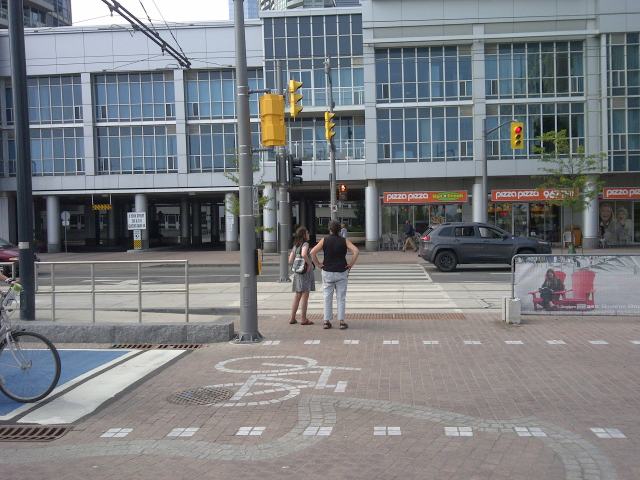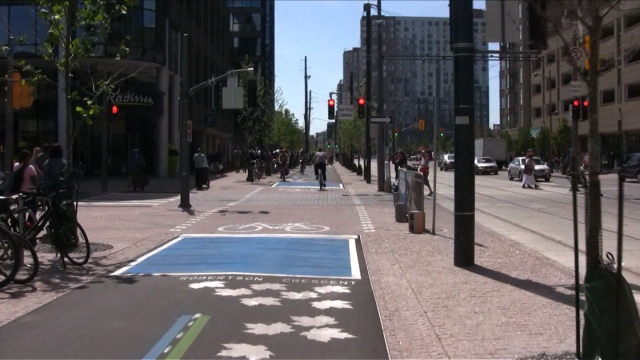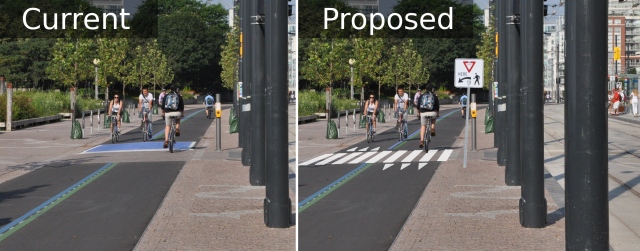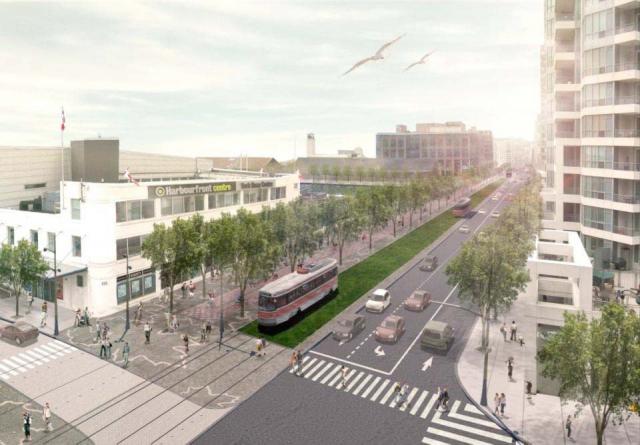Anyone else getting the feeling that the term "shared space" is becoming an easy excuse for bad urban design?
"This street design has created a conflict zone!"
"Uhhh... it's shared space! I totally intended for that to happen!"
Exactly!
What these designers call "shared space" is simply poor design: providing an unclear situation that does not provide the information people need for safely and comfortably navigating the space.
If you look at the conflict point from the pedestrian's perspective, the continuous paving undermines the efforts to subconsciously alert you of a conflict, and many people don't even notice the bicycle path at all. Shared space depends on human interaction, but there can't be a negotiation right-of-way when one party is not even aware of the other.
When you look at the conflict point from the perspective of a cyclist your eyes see the markings clearly delineating the bike path (from that angle) and assume that pedestrians should keep out of your way.
The differing expectations that different road users are given is a recipe for people to get annoyed and upset with each other.
We need to update the design so that it is intuitive to all road users how they should act.
Shared space works well where everyone is traveling slowly and the number of vehicles are low (i.e. dead-end streets). It is not appropriate on a street such as Queens Quay which is one of the major east-west bicycle routes through the city. People's issue of "excessive speed" is equally a symptom of "insufficient design". Keep in mind that no one is complaining about the speed of streetcars and automobiles, which are actually travelling much faster than the bicycles.
A successful nearby example of shared space is Dockside Drive along the waterfront, just next to Sugar Beach. It's only used for local access, so the few people who are driving or cycling are travelling very slowly as there is no clearly delineated space for vehicles - it is visually a pedestrian zone.
All images are from ontariotrafficman.wordpress.com/2015/07/28/queens-quay-boulevard-cycle-track-reconciling-cyclists-and-pedestrians
^^ I couldn't agree more. We have shared space everywhere -- intersections anyone?
I think there is some confusion about what "Shared Space" is. It refers to the designs and theories popularized by Hans Monderman where all delineation and segregation is removed from roadways, and instead road users must negotiate priority with each other.
Intersections are not Shared Space since they have legally-defined rules and expectations. For example a pedestrian crossover is a place where the space is "shared" by pedestrians and vehicle traffic, but it is not "shared space" in the Monderman-ian sense since pedestrians officially have priority over vehicle traffic.
Suggesting that Shared Space can work successfully in a 4m x 4m square within an otherwise highly delineated streetscape is nothing short of absurd. People are all passing straight through the zone, some with considerable momentum.
The most familiar example of Shared Space to us is parking lots: there is no clear right of way in most situations and there usually isn't any separate space for pedestrians or cyclists.





